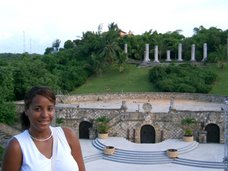Today more than ever, foreign language teachers have a vast source of places to go to enhance the learning of a second language with the use of hands-on material that can be enabled with the use of technology. Prior to the 21st Century, researchers found it hard to predict the teaching of a foreign language with technology. They could not see the extent to which technology has changed the educational environment. For example, they predicted that in the virtual college of the future, students would receive electronic lectures, obtain readings, contribute to discussions, and send e-mail messages. Indeed, they were right, in the present not only are students able to learn about a foreign country (such as, Dominican Republic) through the World Wide Web, but also to practice a foreign language (such as, Spanish) with a native speaker. There are many research-based ideas on how to incorporate technology into the foreign language classroom, such as, the use of word processing, the internet, multimedia presentation programs, publishing programs, and many others like these.
In the article “Using the World Wide Web to Integrate Spanish Language and Culture: A Pilot Study” the author explains how a group of students benefited from using the Internet as a tool to learn Spanish. This study included thirteen college students enrolled in basic Spanish who used the internet to complete five activities. The five activities were created taking into account the Spanish culture and language. For example, one of the activities was to plan a family trip to Madrid. The students had to search the Internet to make all the arrangements to make this vacation possible. They had to find accommodations, restaurants, places of interest, and museums, among others. The researchers found that the use of the Internet helps students gain a better understanding of foreign languages and cultures. The students involved in this study revealed that the Internet is a great place to find interesting things about the Spanish language. Moreover, the students claimed that many times they got side-tracked from the given assignments due to the vast amount of activities and information found. They described the internet as “a good learning tool, more current than just reading about it in a book.” (p.78). My students have completed similar activities and they have expressed how much they have learned and enjoyed doing it, as well.
Applications of the Web in the Spanish Classroom is the title of an amazing PowerPoint that I found while browsing for fun activities to do in my Spanish classes. In this PowerPoint, the teacher, Maria Jose Bermejo, listed a great amount of web sites that teachers can search to help students learn Spanish. I like this PowerPoint because it includes many websites that I like to use in my Spanish classes; all in one place. It enhances the use of learning activities to practice Spanish, such as:
· Scavenger hunts
· Self learning and self check
· Vocabulary, spelling, grammar, among others
· Web quests to Spanish speaking countries
· Latin American places and cultures
In addition, second language acquisition (SLA) researchers have demonstrated how the use of technology increases language learner’s motivation, self-confidence and higher self-esteem. This results in students being more successful and motivated to learn (Marr 2000, Okolo and Ferreri 1998.) The way language learners exhibit on-task behavior when technology is involved helps, not only researchers, but also educators to understand that these students perceive computers as having a positive effect on their learning. Therefore, it is the educator’s responsibility to be prepared to apply technology in the educational settings to produce technology-capable students, which in return will enhance learning. In fact, the International Society for Technology in Education (ISTE) encourages all educators to provide learning opportunities that produce technology-capable students. The National Education Technology Standards (NETS), initiated by the ISTE and funded by the US Department of education and others, suggests curriculum-based strategies that will help teachers accomplish the curriculum-based Foreign Language Standards.
As a Spanish teacher, I encourage the use of techonolgy. I try to engage my students by having them use technology tools in which they are more likely familiar with. We use the internet to search, practice, learn new vocabulry, play games, and more. I really like http://www.quia.com/ because it allows students to play a variety of vocabulary games that are acccurate and fun. Also, I like my students visiting http://www.studyspanish.com/ to practice grammar. For example, the students are able to complete activities in which they need in order to practice the Spanish conjugation, how fun! Finally, Microsoft Office has many neat programs that my students use to create different projects, such as PowerPoint, Movie Maker, Word and more. This coming school year, my students will begin to create a blog in Spanish. There, they will write all about themselves. The title will be "Todo acerca de mi" (they can pretend to be somebody else for security), a project they have done in the past, but this time they will have the opportunity to do it on the internet, and to post it online for others to see their progress, instead of waiting for the final product. I am very excited about this. Wish me luck!
Tuesday, July 17, 2007
Subscribe to:
Post Comments (Atom)


2 comments:
Having taken Spanish from someone who speaks Spanish as their first langauge as opposed to another teacher I had who spoke English as their first language (and wasn't a very good Spanish speaker at that), I understand the importance of practicing the language you are trying to learn with a native speaker. I think it is awesome that there are places like this on the Web! You truly learn so much more from one who is a native speaker of the language!
Have you checked to see if your school blocks the use of blogs. I think we will all have to educate our superiors on the value of these tools. My Space is a blog but not all blogs are dangerous spaces.
Post a Comment